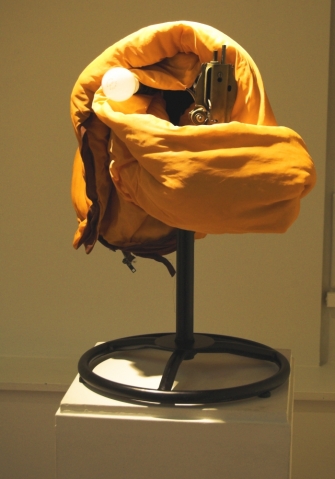- Venue
- City Gallery
- Location
- East Midlands
‘Songs without names’ consists of a collection of found objects, transformed so as to become figures with their own inner lives and histories. Items of furniture most likely retrieved from skips, basements and attics have been revitalised through being joined with unexpected partners, given horns or lightbulbs, or in one case wrapped in an old sleeping bag. More importantly, these emerging identities are modified and shaped by their relation to others; at the centre of the room a loose collective of these figures are placed so as to mutually support and embrace each other, while others seem to observe – sullenly or with longing – from a distance.
Viewed in one way, the collection gently conveys a sense of fragility and peace. An old rusty bucket sits on top of a rickety plastic tripod, gazing down at a mirror-cum-table, shaded in turn by splintered paper parasol, each co-operating with and completing the other. Nearby, an old cabinet entitled ‘Who knows what they put inside us’ nervously opens one of its doors to expose a tiny crack of light coming from within. On further viewing, however, disturbances emerge. A horned chair kneels nearby the central gathering, but perhaps unwillingly, its front legs may be broken rather than bended, its horns suggesting defiance or jealousy. The attentive gaze of the old bucket may also be a disconcertingly hollow and passive stare.
Most ambiguously, an old sewing machine with a lightbulb attached is loosely wrapped in a orange sleeping bag and is entitled ‘I love you’. It sits lifelessly on a metal stand placed on a plinth above all the other pieces, and is the first thing visible on entry. Despite its shapelessness in comparison with the rest of the exhibits, it perhaps provides a focal point for the themes at work in the room. Evoking homelessness or forced migrancy, it suggests the exaltation of the humble – the neglected and forgotten being raised and given centre stage – but equally carries hints of memorial and mourning. Seen in this sense, the whole collection could be seen as a provocation to ask questions of value and neglect, completion and incompletion, gain and loss, both in art and in life.



